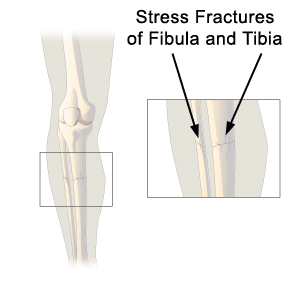Bone Stress Injuries
Hey, there runners! As a physical therapist, I’ve seen my fair share of injuries, and one of my least favorites to see is the dreaded stress fracture. It’s not my least favorite because it cannot be overcome but rather it always requires an absolute rest break from running, unlike many other injuries where we can manage SOME running. In this blog post, I’ll give you the lowdown on what stress fractures are, why they happen, and how to prevent them.
What exactly is a stress fracture?
Essentially, it’s a tiny crack in a bone that’s caused by repetitive stress or overuse. They’re most common in weight-bearing bones like the tibia (shin bone) and the metatarsals (bones in the foot), and they can be pretty painful. Most people think of bones as a rigid, plastic structure, but interestingly enough bone is adaptable to stress like muscle and injury or not, replenishes its cells throughout our lifetime.

So why do stress fractures happen?
The main culprit is overtraining or doing too much too soon. If you’re a new runner or you’re trying to increase your mileage too quickly, your bones may not have enough time to adapt to the increased stress. In addition, certain medical conditions which limit bone health, age, gender, and nutrition all play into your current bone resilience. Most stress fractures will be preceded by a stress reaction that is less severe but needs to be managed to avoid progressing into a bony break.
How can you prevent stress fractures?
Here are a few tips.
Build up your mileage gradually.
This is probably the most important thing you can do to prevent stress fractures. If you’re new to running, start with short, easy runs and gradually increase your mileage by no more than 10% per week. If you’re an experienced runner, don’t try to increase your mileage too quickly. Take your time and give your body time to adapt.

Listen to your body.
Be respectful of new aches/pains to avoid worsening symptoms. This goes for all running injuries! The easiest overuse injury to overcome is one that has just begun.
Mix up your surfaces.
Running on the same surface all the time can put a lot of stress on your bones. Mix things up by running on different surfaces, like grass or trails.
Strengthen your bones.
AS stated previously, just like other bodily tissues, bones respond to stress by getting stronger. Strength training can help improve bone density and reduce the risk of stress fractures. Focus on exercises that target the lower body, like squats and lunges.
If you do end up with a stress fracture, the most important thing you can do is rest. Additionally consulting with a medical professional about proper management is key! The proper imaging may be needed to diagnose the injury. X-ray does not unfortunately catch all bone stress injuries. Depending on the severity of the fracture, you may need to wear a walking boot or even stay off your feet completely for a few weeks. Once you’re healed, it’s important to ease back into running gradually to avoid re-injury.

In conclusion, stress fractures are a common injury among runners that can be debilitating and frustrating. However, with the right approach, it is possible to prevent them and continue enjoying your running adventures. By investing in the right gear, following a proper warm-up and stretching routine, and gradually increasing the intensity of your runs, you can build strong and resilient bones. Moreover, preventing stress fractures is not just about avoiding injury.
Maintaining strong bones is essential for overall health and longevity, especially as we age. Running, when done safely and responsibly, can be a fantastic way to keep your bones healthy, reduce the risk of osteoporosis, and improve your quality of life. So, take care of your bones, listen to your body, and seek professional help when necessary. By doing so, you can stay injury-free and continue to enjoy the many benefits of running. Remember, running is a lifelong journey, and healthy bones are the foundation of a long and active life
Written by Joey Przybyla, PT, DPT
Up and Running Physical Therapy
* * *
Thanks for reading! If you’d like to learn more about who we are and what we do, click this link: https://upandrunningpt.com/

